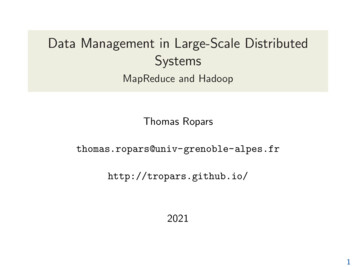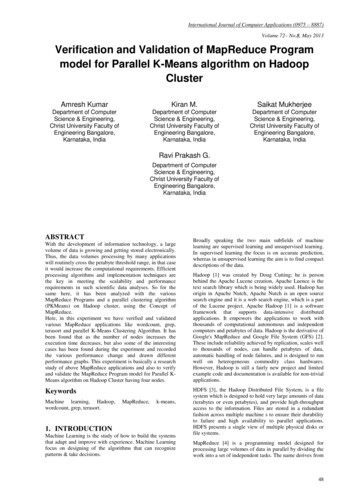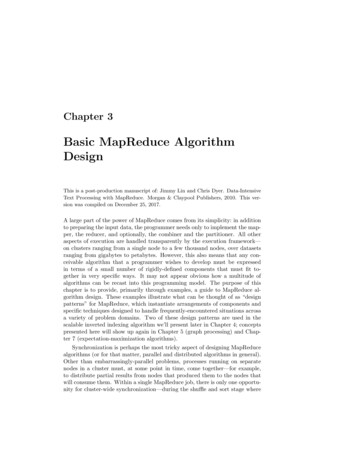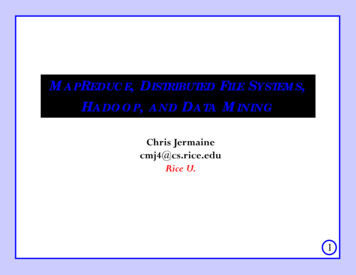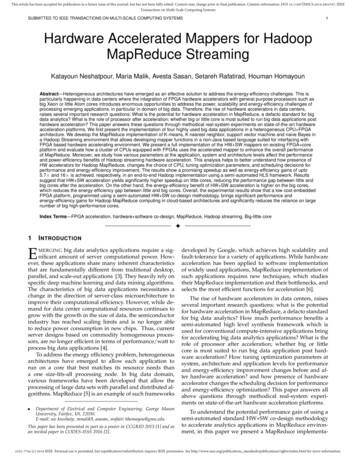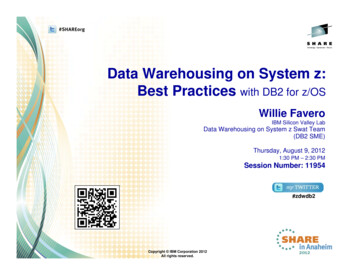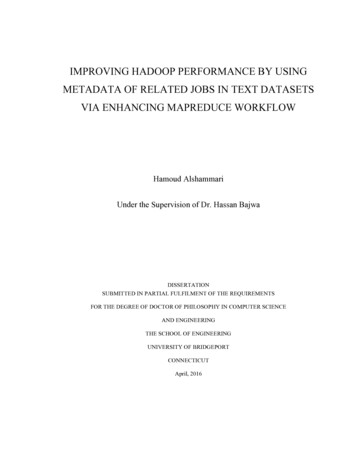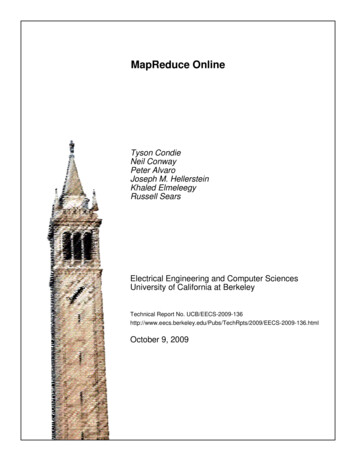
Transcription
Parallel Data Processing with MapReduce: A SurveyKyong-Ha LeeYoon-Joon LeeDepartment of ComputerScienceKAISTHyunsik ChoiYon Dohn ChungDepartment of ComputerScience and EngineeringKorea ACTA prominent parallel data processing tool MapReduce is gaining significant momentum from both industry and academiaas the volume of data to analyze grows rapidly. While MapReduce is used in many areas where massive data analysis is required, there are still debates on its performance, efficiencyper node, and simple abstraction. This survey intends toassist the database and open source communities in understanding various technical aspects of the MapReduce framework. In this survey, we characterize the MapReduce framework and discuss its inherent pros and cons. We then introduce its optimization strategies reported in the recent literature. We also discuss the open issues and challenges raisedon parallel data analysis with MapReduce.1.INTRODUCTIONIn this age of data explosion, parallel processing isessential to processing a massive volume of data in atimely manner. MapReduce, which has been popularized by Google, is a scalable and fault-tolerant dataprocessing tool that enables to process a massive volume of data in parallel with many low-end computingnodes[44, 38]. By virtue of its simplicity, scalability,and fault-tolerance, MapReduce is becoming ubiquitous, gaining significant momentum from both industryand academia. However, MapReduce has inherent limitations on its performance and efficiency. Therefore,many studies have endeavored to overcome the limitations of the MapReduce framework[10, 15, 51, 32, 23].The goal of this survey is to provide a timely remarkon the status of MapReduce studies and related workfocusing on the current research aimed at improvingand enhancing the MapReduce framework. We give anoverview of major approaches and classify them withrespect to their strategies. The rest of the survey is organized as follows. Section 2 reviews the architectureand the key concepts of MapReduce. Section 3 discusses the inherent pros and cons of MapReduce. Section 4 presents the classification and details of recentapproaches to improving the MapReduce framework.In Section 5 and 6, we overview major application do-SIGMOD Record, December 2011 (Vol. 40, No. 4)Bongki MoonDepartment of ComputerScienceUniversity of Arizonabkmoon@cs.arizona.edumains where the MapReduce framework is adopted anddiscuss open issues and challenges. Finally, Section 7concludes this survey.2.ARCHITECTUREMapReduce is a programming model as well as aframework that supports the model. The main ideaof the MapReduce model is to hide details of parallelexecution and allow users to focus only on data processing strategies. The MapReduce model consists oftwo primitive functions: Map and Reduce. The inputfor MapReduce is a list of (key1, value1) pairs andMap() is applied to each pair to compute intermediate key-value pairs, (key2, value2). The intermediatekey-value pairs are then grouped together on the keyequality basis, i.e. (key2, list(value2)). For each key2,Reduce() works on the list of all values, then produceszero or more aggregated results. Users can define theMap() and Reduce() functions however they want theMapReduce framework works.MapReduce utilizes the Google File System(GFS) asan underlying storage layer to read input and store output[59]. GFS is a chunk-based distributed file systemthat supports fault-tolerance by data partitioning andreplication. Apache Hadoop is an open-source Javaimplementation of MapReduce[81]. We proceed ourexplanation with Hadoop since Google’s MapReducecode is not available to the public for its proprietaryuse. Other implementations (such as DISCO writtenin Erlang[6]) are also available, but not as popular asHadoop. Like MapReduce, Hadoop consists of two layers: a data storage layer called Hadoop DFS(HDFS)and a data processing layer called Hadoop MapReduceFramework. HDFS is a block-structured file systemmanaged by a single master node like Google’s GFS.Each processing job in Hadoop is broken down to asmany Map tasks as input data blocks and one or moreReduce tasks. Figure 1 illustrates an overview of theHadoop architecture.A single MapReduce(MR) job is performed in twophases: Map and Reduce stages. The master picks idle11
workers and assigns each one a map or a reduce taskaccording to the stage. Before starting the Map task,an input file is loaded on the distributed file system. Atloading, the file is partitioned into multiple data blockswhich have the same size, typically 64MB, and eachblock is triplicated to guarantee fault-tolerance. Eachblock is then assigned to a mapper, a worker which isassigned a map task, and the mapper applies Map() toeach record in the data block. The intermediate outputs produced by the mappers are then sorted locallyfor grouping key-value pairs sharing the same key. Afterlocal sort, Combine() is optionally applied to performpre-aggregation on the grouped key-value pairs so thatthe communication cost taken to transfer all the intermediate outputs to reducers is minimized. Then themapped outputs are stored in local disks of the mappers, partitioned into R, where R is the number of Reduce tasks in the MR job. This partitioning is basicallydone by a hash function e.g. , hash(key) mod R.When all Map tasks are completed, the MapReducescheduler assigns Reduce tasks to workers. The intermediate results are shuffled and assigned to reducers viaHTTPS protocol. Since all mapped outputs are alreadypartitioned and stored in local disks, each reducer performs the shuffling by simply pulling its partition of themapped outputs from mappers. Basically, each recordof the mapped outputs is assigned to only a single reducer by one-to-one shuffling strategy. Note that thisdata transfer is performed by reducers’ pulling intermediate results. A reducer reads the intermediate resultsand merge them by the intermediate keys, i.e. key2, sothat all values of the same key are grouped together.This grouping is done by external merge-sort. Theneach reducer applies Reduce() to the intermediate values for each key2 it encounters. The output of reducersare stored and triplicated in HDFS.Note that the number of Map tasks does not dependon the number of nodes, but the number of input blocks.Each block is assigned to a single Map task. However,all Map tasks do not need to be executed simultaneouslyand neither are Reduce tasks. For example, if an inputis broken down into 400 blocks and there are 40 mappersin a cluster, the number of map tasks are 400 and themap tasks are executed through 10 waves of task runs.This behavior pattern is also reported in [60].The MapReduce framework executes its tasks basedon runtime scheduling scheme. It means that MapReduce does not build any execution plan that specifieswhich tasks will run on which nodes before execution.While DBMS generates a query plan tree for execution,a plan for executions in MapReduce is determined entirely at runtime. With the runtime scheduling, MapReduce achieves fault tolerance by detecting failures andreassigning tasks of failed nodes to other healthy nodesin the cluster. Nodes which have completed their tasks12Figure 1: Hadoop Architectureare assigned another input block. This scheme naturally achieves load balancing in that faster nodes willprocess more input chunks and slower nodes processless inputs in the next wave of execution. Furthermore,MapReduce scheduler utilizes a speculative and redundant execution. Tasks on straggling nodes are redundantly executed on other idle nodes that have finishedtheir assigned tasks, although the tasks are not guaranteed to end earlier on the new assigned nodes thanon the straggling nodes. Map and Reduce tasks areexecuted with no communication between other tasks.Thus, there is no contention arisen by synchronizationand no communication cost between tasks during a MRjob execution.3.3.1PROS AND CONSDebatesAs suggested by many researchers, commercial DBMSshave adopted “one size fits all” strategy and are notsuited for solving extremely large scale data processingtasks. There has been a demand for special-purposedata processing tools that are tailored for such problems[79, 50, 72]. While MapReduce is referred to as a newway of processing big data in data-center computing[77], it is also criticized as a “major step backwards” inparallel data processing in comparison with DBMS [10,15]. However, many MapReduce proponents in industry argue that MapReduce is not a DBMS and suchan apple-to-orange comparison is unfair. As the technical debate continued, ACM recently invited both sidesin January edition of CACM, 2010 [51, 39]. Panels inDOLAP’10 also discussed pros and cons of MapReduceand relational DB for data warehousing [23].Pavlo et al ’s comparison show that Hadoop is 2 50times slower than parallel DBMS except in the case ofSIGMOD Record, December 2011 (Vol. 40, No. 4)
data loading [15]. Anderson et al also criticize that thecurrent Hadoop system is scalable, but achieves verylow efficiency per node, less than 5MB/s processingrates, repeating a mistake that previous studies on highperformance systems often made by “focusing on scalability but missing efficiency” [32]. This poor efficiencyinvolves many issues such as performance, total costof ownership(TCO) and energy. Although Hadoop wonthe 1st position in GraySort benchmark test for 100 TBsorting(1 trillion 100-byte records) in 2009, its winningwas achieved with over 3,800 nodes [76]. MapReduceor Hadoop would not be a cheap solution if the costfor constructing and maintaining a cluster of that sizewas considered. Other studies on the performance ofHadoop are also found in literature [28, 61]. Analysisof 10-months of MR logs from Yahoo’s M45 Hadoopcluster and MapReduce usage statistics at Google arealso available [60, 9].The studies exhibit a clear tradeoff between efficiencyand fault-tolerance. MapReduce increases the fault tolerance of long-time analysis by frequent checkpoints ofcompleted tasks and data replication. However, the frequent I/Os required for fault-tolerance reduce efficiency.Parallel DBMS aims at efficiency rather than fault tolerance. DBMS actively exploits pipelining intermediateresults between query operators. However, it causes apotential danger that a large amount of operations needbe redone when a failure happens. With this fundamental difference, we categorize the pros and cons of theMapReduce framework below.3.2AdvantagesMapReduce is simple and efficient for computing aggregate. Thus, it is often compared with “filtering thengroup-by aggregation” query processing in a DBMS. Hereare major advantages of the MapReduce framework fordata processing.Simple and easy to use The MapReduce model is simple but expressive. With MapReduce, a programmer defines his job with only Map and Reducefunctions, without having to specify physical distribution of his job across nodes.Flexible MapReduce does not have any dependency ondata model and schema. With MapReduce a programmer can deal with irregular or unstructureddata more easily than they do with DBMS.Independent of the storage MapReduce is basicallyindependent from underlying storage layers. Thus,MapReduce can work with different storage layerssuch as BigTable[35] and others.Fault tolerance MapReduce is highly fault-tolerant.For example, it is reported that MapReduce cancontinue to work in spite of an average of 1.2 failures per analysis job at Google[44, 38].SIGMOD Record, December 2011 (Vol. 40, No. 4)High scalability The best advantage of using MapReduce is high scalability. Yahoo! reported thattheir Hadoop gear could scale out more than 4,000nodes in 2008[4].3.3PitfallsDespite many advantages, MapReduce lacks some ofthe features that have proven paramount to data analysis in DBMS. In this respect, MapReduce is often characterized as an Extract-Transform-Load (ETL) tool[51].We itemize the pitfalls of the MapReduce frameworkbelow, compared with DBMS.No high-level language MapReduce itself does notsupport any high-level language like SQL in DBMSand any query optimization technique. Users shouldcode their operations in Map and Reduce functions.No schema and no index MapReduce is schema-freeand index-free. An MR job can work right afterits input is loaded into its storage. However, thisimpromptu processing throws away the benefits ofdata modeling. MapReduce requires to parse eachitem at reading input and transform it into dataobjects for data processing, causing performancedegradation [15, 11].A Single fixed dataflow MapReduce provides the easeof use with a simple abstraction, but in a fixeddataflow. Therefore, many complex algorithms arehard to implement with Map and Reduce only inan MR job. In addition, some algorithms that require multiple inputs are not well supported sincethe dataflow of MapReduce is originally designedto read a single input and generate a single output.Low efficiency With fault-tolerance and scalability asits primary goals, MapReduce operations are notalways optimized for I/O efficiency. (Consider forexample sort-merge based grouping, materialization of intermediate results and data triplicationon the distributed file system.) In addition, Mapand Reduce are blocking operations. A transition to the next stage cannot be made until allthe tasks of the current stage are finished. Consequently, pipeline parallelism may not be exploited.Moreover, block-level restarts, a one-to-one shuffling strategy, and a simple runtime scheduling canalso lower the efficiency per node. MapReducedoes not have specific execution plans and does notoptimize plans like DBMS does to minimize datatransfer across nodes. Therefore, MapReduce often shows poorer performance than DBMS[15]. Inaddition, the MapReduce framework has a latencyproblem that comes from its inherent batch processing nature. All of inputs for an MR job shouldbe prepared in advance for processing.13
Very young MapReduce has been popularized by Googlesince 2004. Compared to over 40 years of DBMS,codes are not mature yet and third-party toolsavailable are still relatively few.4.VARIANTS AND IMPROVEMENTSWe present details of approaches to improving thepitfalls of the MapReduce framework in this section.4.1High-level LanguagesMicrosoft SCOPE[53], Apache Pig[22, 18], and ApacheHive[16, 17] all aim at supporting declarative query languages for the MapReduce framework. The declarativequery languages allow query independence from program logics, reuse of the queries and automatic queryoptimization features like SQL does for DBMS. SCOPEworks on top of the Cosmos system, a Microsoft’s cloneof MapReduce, and provides functionality similar toSQL views. It is similar to SQL but comes with C# expressions. Operators in SCOPE are the same as Map,Reduce and Merge supported in [37].Pig is an open source project that is intended to support ad-hoc analysis of very large data, motivated bySawzall[55], a scripting language for Google’s MapReduce. Pig consists of a high-level dataflow languagecalled Pig Latin and its execution framework. Pig Latinsupports a nested data model and a set of pre-definedUDFs that can be customized [22]. The Pig executionframework first generates a logical query plan from a PigLatin program. Then it compiles the logical plan downinto a series of MR jobs. Some optimization techniquesare adopted to the compilation, but not described indetail[18]. Pig is built on top of Hadoop framework,and its usage requires no modification to Hadoop.Hive is an open-source project that aims at providingdata warehouse solutions on top of Hadoop, supportingad-hoc queries with an SQL-like query language calledHiveQL. Hive compiles a HiveQL query into a directedacyclic graph(DAG) of MR jobs. The HiveQL includesits own type system and data definition language(DDL)to manage data integrity. It also contains a systemcatalog, containing schema information and statistics,much like DBMS engines. Hive currently provides onlya simple, naive rule-based optimizer.Similarly, DryadLINQ[71, 49] is developed to translate LINQ expressions of a program into a distributedexecution plan for Dryad, Microsoft’s parallel data processing tool [48].4.2Schema SupportAs described in Section 3.3, MapReduce does notprovide any schema support. Thus, the MapReduceframework parses each data record at reading input,causing performance degradation [15, 51, 11]. Meanwhile, Jiang et al report that only immutable decoding14that transforms records into immutable data objectsseverely causes performance degradation, rather thanrecord parsing [28].While MapReduce itself does not provide any schemasupport, data formats such as Google’s Protocol Buffers,XML, JSON, Apache’s Thrift, or other formats can beused for checking data integrity [39]. One notable thingabout the formats is that they are self-describing formats that support a nested and irregular data model,rather than the relational model. A drawback of the useof the formats is that data size may grow as data contains schema information in itself. Data compression isconsidered to address the data size problem [47].4.3Flexible Data FlowThere are many algorithms which are hard to directlymap into Map and Reduce functions. For example,some algorithms require global state information during their processing. Loop is a typical example thatrequires the state information for execution and termination. However, MapReduce does not treat stateinformation during execution. Thus, MapReduce readsthe same data iteratively and materializes intermediate results in local disks in each iteration, requiring lotsof I/Os and unnecessary computations. HaLoop[66],Twister[42], and Pregel[36] are examples of systems thatsupport loop programs in MapReduce.HaLoop and Twister avoid reading unnecessary datarepeatedly by identifying and keeping invariant dataduring iterations. Similarly, Lin et al propose an inmapper combining technique that preserves mapped outputs in a memory buffer across multiple map calls, andemits aggregated outputs at the last iteration [75]. Inaddition, Twister avoids instantiating workers repeatedly during iterations. Previously instantiated workersare reused for the next iteration with different inputsin Twister. HaLoop is similar to Twister, and it alsoallows to cache both each stage’s input and output tosave more I/Os during iterations. Vanilla Hadoop alsosupports task JVM reuse to avoid the overhead of starting a new JVM for each task [81]. Pregel mainly targets to process graph data. Graph data processing areusually known to require lots of iterations. Pregel implements a programming model motivated by the BulkSynchronous Parallel(BSP) model. In this model, eachnode has each own input and transfers only some messages which are required for next iteration to othernodes.MapReduce reads a single input. However, many important relational operators are binary operators thatrequire two inputs. Map-Reduce-Merge addresses thesupport of the relational operators by simply adding athird merge stage after reduce stage [37]. The mergestage combines two reduced outputs from two differentMR jobs into one.SIGMOD Record, December 2011 (Vol. 40, No. 4)
Clustera, Dryad and Nephele/PACT allow more flexible dataflow than MapReduce does [31, 48, 30, 26].Clustera is a cluster management system that is designed to handle a variety of job types including MRstyle jobs [31]. Job scheduler in Clustera handles MapReduce, workflow and SQL-type jobs, and each job can beconnected to form a DAG or a pipeline for complexcomputations.Dryad is a notable example of distributed data-paralleltool that allows to design and execute a dataflow graphas users’ wish [48]. The dataflow in Dryad has a form ofDAG that consists of vertices and channels. Each vertexrepresents a program and a channel connects the vertices. For execution, a logical dataflow graph is mappedonto physical resources by a job scheduler at runtime.A vertex runs when all its inputs are ready and outputsits results to the neighbor vertices via channels as defined in the dataflow graph. The channels can be eitherof files, TCP pipes, or shared-memory. Job executionsare controlled by a central job scheduler. Redundantexecutions are also allowed to handle apparently veryslow vertices, like MapReduce. Dryad also allows todefine how to shuffle intermediate data specifically.Nephele/PACT is another parallel execution engineand its programming model[30, 26]. The PACT modelextends MapReduce to support more flexible dataflows.In the model, each mapper can have a separate inputand a user can specify its dataflow with more variousstages including Map and Reduce. Nephele transformsa PACT program into a physical DAG then executes theDAG across nodes. Executions in Nephele are scheduledat runtime, like MapReduce.4.4Blocking OperatorsMap and Reduce functions are blocking operations inthat all tasks should be completed to move forward tothe next stage or job. The reason is that MapReducerelies on external merge sort for grouping intermediateresults. This property causes performance degradationand makes it difficult to support online processing.Logothetis et al address this problem for the first timewhen they build MapReduce abstraction onto their distributed stream engine for ad-hoc data processing[29].Their incremental MapReduce framework processes datalike streaming engines. Each task runs continuouslywith a sliding window. Their system generates MRoutputs by reading the items within the window. Thisstream-based MapReduce processes arriving incrementsof update tuples, avoiding recomputation of all the tuples from the beginning.MapReduce Online is devised to support online aggregation and continuous queries in MapReduce[63]. Itraises an issue that pull-based communication and checkpoints of mapped outputs limit pipelined processing. Topromote pipelining between tasks, they modify MapRe-SIGMOD Record, December 2011 (Vol. 40, No. 4)duce architecture by making Mappers push their datatemporarily stored in local storage to Reducers periodically in the same MR job. Map-side pre-aggregation isalso used to reduce communication volumes further.Li et al and Jiang et al have found that the merge sortin MapReduce is I/O intensive and dominantly affectsthe performance of MapReduce [21, 28]. This leads tothe use of hash tables for better performance and alsoincremental processing [21]. In the study, as soon aseach map task outputs its intermediate results, the results are hashed and pushed to hash tables held by reducers. Then, reducers perform aggregation on the values in each bucket. Since each bucket in the hash tableholds all values which correspond to a distinct key, nogrouping is required. In addition, reducers can performaggregation on the fly even when all mappers are notcompleted yet.4.5I/O OptimizationThere are also approaches to reducing I/O cost inMapReduce by using index structures, column-orientedstorage, or data compression.Hadoop provides an index-structured file formatto improve the I/O cost of Hadoop [40]. However, as itneeds to build an index for each file partition at dataloading stage, loading time is significantly increased.If the input data are processed just once, the additional cost given by building index may not be justified.HadoopDB also benefits from DB indexes by leveragingDBMS as a storage in each node [11].There are many studies that describe how columnoriented techniques can be leveraged to improve MapReduce’s performance dramatically [35, 62, 68, 12, 69].Google’s BigTable proposes the concept of column family that groups one or more columns as a basic workingunit[35]. Google’s Dremel is a nested column-orientedstorage that is designed to complement MapReduce[62].The read-only nested data in Dremel are modeled withProtocol Buffers [47]. The data in Dremel are split intomultiple columns and records are assembled via finitestate machines for record-oriented requests. Dremel isalso known to support ad-hoc queries like Hive [16].Record Columnar File(RCFile), developed by Facebook and adopted by Hive and Pig, is a column-orientedfile format on HDFS [68]. Data placement in HDFS isdetermined by the master node at runtime. Thus, it isargued that if each column in a relation is independentlystored in a separate file on HDFS, all related fields inthe same record cannot guarantee to be stored in thesame node. To get around this, a file format that represents all values of a relation column-wise in a singlefile is devised. A RCFile consists of a set of row groups,which are acquired by partitioning a relation horizontally. Then in each row group, values are enumeratedin column-wise, similar to PAX storage scheme [3].15
Llama shows how column-wise data placement helpsjoin processing [69]. A column-oriented file in Llamastores a particular column data with optional index information. It also witnesses that late materializationwhich delays record reconstruction until the columnis necessary during query processing is no better thanearly materialization in many cases.Floratou et al propose a binary column-oriented storage that boosts the performance of Hadoop by an order of magnitude[12]. Their storage format stores eachcolumn in a separate file but co-locate associated column files in the same node by changing data placementpolicy of Hadoop. They also suggest that late materialization with skiplist shows better performance thanearly materialization, contrary to the result of RCFile.Both Floratou’s work and RCFile also use a columnwise data compression in each row group, and adopt alazy decompression technique to avoid unnecessary decompression during query execution. Hadoop also supports the compression of mapped outputs to save I/Osduring the checkpoints[81].4.6SchedulingMapReduce uses a block-level runtime scheduling witha speculative execution. A separate Map task is createdto process a single data block. A node which finishes itstask early gets more tasks. Tasks on a straggler nodeare redundantly executed on other idle nodes.Hadoop scheduler implements the speculative taskscheduling with a simple heuristic method which compares the progress of each task to the average progress.Tasks with the lowest progress compared to the averageare selected for re-execution. However, this heuristicmethod is not well suited in a heterogeneous environment where each node has different computing power.In this environment, even a node whose task progressesfurther than others may be the last if the node’s computing power is inferior to others. Longest Approximate Time to End(LATE) scheduling is devised to improve the response time of Hadoop in heterogeneous environments [52]. This scheduling scheme estimates thetask progress with the progress rate, rather than simpleprogress score.Parallax is devised to estimate job progress more precisely for a series of jobs compiled from a Pig program [45]. it pre-runs with sampled data for estimatingthe processing speeds of each stage. ParaTimer is an extended version of Parallax for DAG-style jobs written inPig [46]. ParaTimer identifies a critical path that takeslonger than others in a parallel query plan. It makesthe indicator ignore other shorter paths when estimating progress since the longest path would contribute theoverall execution time. Besides, it is reported that themore data blocks to be scheduled, the more cost thescheduler will pay [65]. Thus, a rule of thumb in in-16dustry – making the size of data block bigger makesHadoop work faster – is credible.We now look into multi-user environment wherebyusers simultaneously execute their jobs in a cluster.Hadoop implements two scheduling schemes: fair scheduling and capacity scheduling. The default fair schedulingworks with a single queue of jobs. It assigns physicalresources to jobs such that all jobs get an equal shareof resources over time on average. In this schedulingscheme, if there is only a single MR job running in acluster, The job solely uses entire resources in the cluster. Capacity sharing supports designing more sophisticated scheduling. It provides multiple queues each ofwhich is guaranteed to possess a certain capacity of thecluster.MRShare is a remarkable work for sharing multiplequery executions in MapReduce [64]. MRShare, inspired by multi query optimization techniques in database,finds an optimal way of grouping a set of queries usingdynamic programming. They suggest three sharing opportunities across multiple MR jobs in MapReduce, likefound in Pig [18]: scan sharing, mapped outputs sharing, and Map function sharing. They also introducea cost model for MR jobs and validate this with experiments. Their experiments show that intermediateresult sharing improves the execution time significantly.In addition, they have found that sharing all scans yieldpoorer performance as the size of intermediate resultsincreases, because of the complexity of the merge-sortoperation in MapReduce. Suppose that D is the sizeof input data that n MR jobs share. When sharing allscans, the cost of scanning inputs is reduced by D ,compared to n · D for no sharing scans. However, as aresult, the complexity of sorting the combined mappedoutput of all jobs will be O(n · D log(n · D )) sinceeach job can generate its own mapped output with sizeO( D ). This cost can be bigger than the total cost ofsorting n different jobs, O(n · D log D ) in some cases.4.7JoinsJoin is a popular operator that is not so well dealtwith by Map and Reduce functions. Since MapReduceis designed for processing a single input, the support ofjoins that require more than two inputs with MapReduce has been an open issue. We roughly classify joinmethods within MapReduce into two groups: Map-sidejoin and Reduce-side join. We also borrow some ofterms from Blanas et al ’s study, which compares manyjoin techniques for analysis of clickstream logs at Facebook [57], for explaining join techniques.Map-side JoinMap-Merge join is a common map-side
In this age of data explosion, parallel processing is essential to processing a massive volume of data in a timely manner. MapReduce, which has been popular-ized by Google, is a scalable and fault-tolerant data processing tool that enables to process a massive vol-ume of data in parallel with many low-end computing nodes[44, 38].

